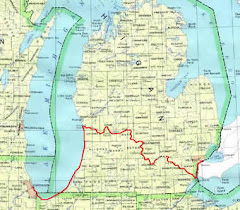Some have questioned my
.jpg)
conclusion that "whitewood" meant the Tuliptree, suggesting instead that the pioneers might have been referring to the Basswood (tilia Americana).
"A Field Guide to Trees and Shrubs" by George A. Petrides says about the Tuliptree: Indians made trunks into dugout canoes.
"The Audubon Field Guide to North American Trees" says:Pioneers hollowed out a single log to make a long, lightweight canoe.
Neither field guide attributes such use to Basswood but both note that its fibrous inner bark was used by Indians for making ropes and mats.
.jpg)
Referring to the Tuliptree in "Tree Habits, How to Know the Hardwoods", author Joseph S. Illick says: In some places the local name canoe-wood is applied for the reason that the Indians formerly made their dugout canoes of the trunks.
Donald Curloss Peattie in a "Natural History of Trees" wrote regarding the Tuliptree: More commonly the pioneer made a fine canoe out of this straight-growing tree, hollowing out a single log to extreme thinness, for the wood is easy to work and one of the lightest in the forest. Such a canoe sixty feet long did Daniel Boone make, when his fortunes were low, and into it he piled his family and gear and sailed away down the Ohio into Spanish territory, away from the ingrate Kentucky.

In "Trees of Michigan and the Upper Great Lakes", Norman F. Smith, then of the Michigan Department of Conservation, said:... the lumber of the tulip tree is sold commercially as 'yellow poplar' or just' poplar'. Years ago it was often marketed as ' whitewood'.
"American Woods" by Shelly E. Schoonover contains a list of common names in use for Tuliptree. Among those are "White-wood" which she says is used in Vermont, Massachusetts, Rhode Island, Connecticut, New York, New Jersey, Delaware, South Carolina, Kentucky, Ohio, Illinois, Michigan, Ontario, and the trade.
The question has also been raised as to why Bois Blanc Island in Lake Huron is so named when it is far north of where Tuliptrees grow. In French Bois Blanc means "white woods" (as in forest), not "whitewood". Without a doubt the Lake Huron Island was named for its expanses of Paper Birch and Aspen ("popple" to the Michigan Deer hunter) along its shore.
The same cannot be said for Bois Blanc (Boblo) Island in the Detroit River which is well south of where the Paper Birch grows. I have not found an account of its naming, but I speculate that the the "white woods" the French explorers saw was largely made up of riverside Sycamores. The upper trunks and branches of Sycamore tress are strikingly white when leafless.
That's the end of my "whitewood" dugout stories and speculations. Dugout canoes made in the Northern Lower Peninsula and the Upper Peninsula were usually made of White Cedar or White Pine. I have some stuff I can pass along on them.


No comments:
Post a Comment